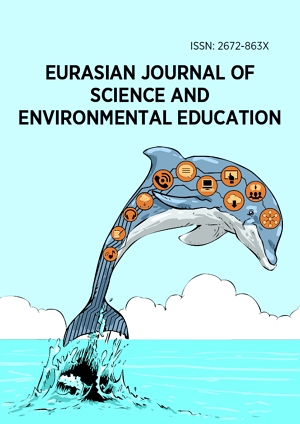Research Article
How to make the engage really engaging: A framework for an instructional approach for the pre-service teachers
More Detail
1 Texas Christian University, Fort Worth, TX, USA* Corresponding Author
Eurasian Journal of Science and Environmental Education, 3(1), June 2023, 1-5, https://doi.org/10.30935/ejsee/12706
Published Online: 12 December 2022, Published: 01 January 2023
OPEN ACCESS 1911 Views 1168 Downloads
ABSTRACT
The five phases of the 5E instructional model based on the constructivist learning theory encourages inquiry in the science classroom. The first, engage phase of the 5E inquiry model plays a critical role in piquing students’ interest and in the pre-diagnostic assessment before beginning the lesson. In this study, 55 pre-service teachers (PSTs) enrolled into a science methods course and participated in a qualitative research study. Using the 5E instructional approach, PSTs planned and implemented peer teaching and field teaching. The data from the PSTs inquiry-based peer teaching lesson plans, field teaching lesson plans, peer teaching sessions, and PST interviews were constantly compared and analyzed. The results showed that only 56% of the PSTs planned lessons with good engage phase that relates to the objective of the lesson, with good questions to assess students’ knowledge and spur their curiosity. Based on the results of this study, we came up with a framework to design a good engage phase:
- Engage phase must relate to the objective of the lesson.
- Engage phase must assess students’ prior knowledge and identify their misconceptions.
- Engage phase must create curiosity among students.
- Engage phase must relate to the objective of the lesson.
- Engage phase must assess students’ prior knowledge and identify their misconceptions.
- Engage phase must create curiosity among students.
CITATION (APA)
Enugu, R. K., & Hokayem, H. (2023). How to make the engage really engaging: A framework for an instructional approach for the pre-service teachers. Eurasian Journal of Science and Environmental Education, 3(1), 1-5. https://doi.org/10.30935/ejsee/12706
REFERENCES
- Abrahams, I., & Millar, R. (2008). Does practical work really work? A study of the effectiveness of practical work as a teaching and learning method in school science. International Journal of Science Education, 30(14), 1945-1969. https://doi.org/10.1080/09500690701749305
- Allen, D., & Tanner, K. D. (2002). Approaches to cell biology teaching: Questions about questions. Cell Biology Education, 1(3), 63-67. https://doi.org/10.1187/cbe.02-07-0021
- Bybee, R., Taylor, J., Gardener, A., Scotter, P. V., Powell, C. J., Westbrook, A., & Landes, N. (2006). The BSCE 5e instructional model: Origins and effectiveness. BSCS Science Learning. https://bscs.org/reports/the-bscs-5e-instructional-model-origins-and-effectiveness/
- Driver, R. (1985). Children’s ideas in science. McGraw-Hill Education.
- Duran, B. L., & Duran, E. (2004). The 5E instructional model: A learning cycle approach for inquiry-based science teaching. The Science Education Review, 3(2), 49-58.
- Furtak, E. M. (2006). The problem with answers: An exploration of guided scientific inquiry teaching. Science Education, 90(3), 453-467. https://doi.org/10.1002/sce.20130
- Glaser, B. (1965). The constant comparative method of qualitative analysis. Social Problems, 12(4), 436-445. https://doi.org/10.1525/sp.1965.12.4.03a00070
- Higgins, J., & Moeed, A. (2017). Fostering curiosity in science classrooms: Inquiring into practice using cogenerative dialoguing. Science Education International, 28(3), 190-198. https://doi.org/10.33828/sei.v28.i3.2
- Hodson, D. (2014). Learning science, learning about science, doing science: Different goals demand different learning methods. International Journal of Science Education, 36(15), 2534-2553. https://doi.org/10.1080/09500693.2014.899722
- Lawson, A. E. (2009). Teaching inquiry science in middle and secondary schools. SAGE.
- Luce, M. R., & Hsi, S. (2015). Science-relevant curiosity expression and interest in science: An exploratory study. Science Education, 99(1), 70-97. https://doi.org/10.1002/sce.21144
- Millar, R. (2010). Analysing practical science activities to assess and improve their effectiveness. The Association of Science Education. https://www.stem.org.uk/elibrary/resource/33677
- NRC. (2012). A framework for K-12 science education: Practices, crosscutting concepts, and core ideas. The National Academies Press.
- Schinske, J. N., Clayman, K., Busch, A. K., Tanner, K. D. (2008). Teaching the anatomy of a scientific journal article. Science Teacher, 75(7), 49-56.
- Taber, K. S. (2014). Methodological issues in science education research: A perspective from the philosophy of science. In M. Matthews (Ed.), International handbook of research in history, philosophy, and science teaching (pp. 1839-1893). Springer. https://doi.org/10.1007/978-94-007-7654-8_57
- Tanner, K. D. (2010). Order matters: Using the 5E model to align teaching with how people learn. CBE-Life Sciences Education, 9(3), 159-164. https://doi.org/10.1187/cbe.10-06-0082
- Uno, G. (1999). Handbook on teaching undergraduate science courses: A survival training manual. Thomson Custom Publishing.

 The articles published in this journal are licensed under the CC-BY Creative Commons Attribution International License.
The articles published in this journal are licensed under the CC-BY Creative Commons Attribution International License.